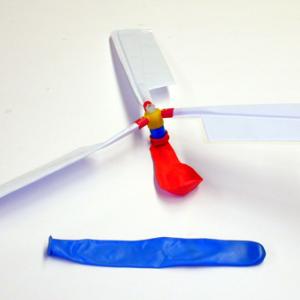College of Liberal Arts & Sciences
10C10.30 - Balloon Helicopter
Attach the balloon to the removable collar. Blow up the balloon and pinch off the neck. Attach the collar back to the helicopter fins. Release and watch the rotation. Note: Either round or long balloons will work.
- Yee-kong Ng, Se-Yuen Mak, and Choi-man Chung, "Demonstration of Newton's Third Law Using a Balloon Helicopter", TPT, Vol. 40, #3, Mar. 2002, p. 181.
- George Gerhab, "The Balloon-O-Copter", TPT, Vol. 32, #4, Apr. 1994, p. 215.
- "A Simple Aerial Toy", The Boy Mechanic Makes Toys, p. 176.
- Janice VanCleave, "64. Right or Left?", Physics for Every Kid - 101 Easy Experiments in Motion, Heat, Light, Machines, and Sound, p. 150 - 151.
- Janice VanCleave, "63. Helicopter", Physics for Every Kid - 101 Easy Experiments in Motion, Heat, Light, Machines, and Sound, p. 148 - 149.
- Robert Ehrlich, "C.11. Water Rocket, Rocket Balloon, and Balloon-Powered Helicopter", Turning the World Inside Out, p. 33 - 34.
Disclaimer: These demonstrations are provided only for illustrative use by persons affiliated with The University of Iowa and only under the direction of a trained instructor or physicist. The University of Iowa is not responsible for demonstrations performed by those using their own equipment or who choose to use this reference material for their own purpose. The demonstrations included here are within the public domain and can be found in materials contained in libraries, bookstores, and through electronic sources. Performing all or any portion of any of these demonstrations, with or without revisions not depicted here entails inherent risks. These risks include, without limitation, bodily injury (and possibly death), including risks to health that may be temporary or permanent and that may exacerbate a pre-existing medical condition; and property loss or damage. Anyone performing any part of these demonstrations, even with revisions, knowingly and voluntarily assumes all risks associated with them.
